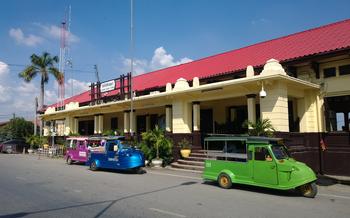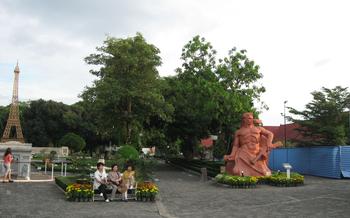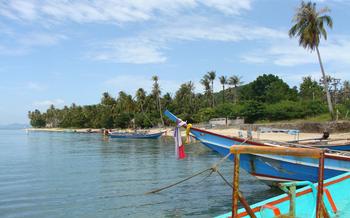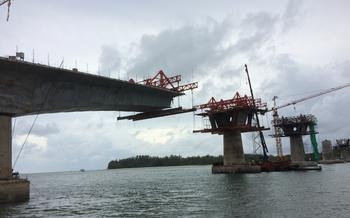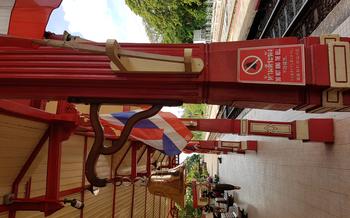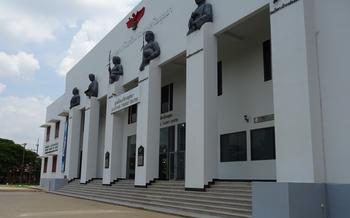
Trang's Rubber Plantations
- Historical Background
- Rubber Tree Species in Trang
- Rubber Plantation Tours
- Harvesting and Processing of Rubber
- Economic Importance of Rubber in Trang
- Environmental Impact of Rubber Plantations
- Unique Rubber Products from Trang
- Rubber Research and Development
- Rubber Festivals and Events
- Rubber Museums and Exhibitions
- Rubber Cuisine
- Rubber Art and Handicrafts
- Rubberwood Furniture and Products
- Rubber Agroforestry
- Insider Tip
Historical Background
Rubber plantations have a rich history in Trang, dating back to the early 1900s when rubber trees were first introduced to the region by European colonists. The fertile soil and favorable climate of Trang proved ideal for rubber cultivation, and the industry quickly flourished. By the 1960s, Trang had become one of the leading rubber-producing regions in Thailand, contributing significantly to the country's economy.
Key players in the development of the rubber industry in Trang included local farmers, government agencies, and foreign investors. Smallholder farmers played a crucial role in expanding rubber cultivation, while government initiatives and incentives supported the industry's growth. Foreign investors, particularly from Malaysia and Singapore, brought expertise and capital, contributing to the establishment of large-scale rubber plantations.
The rubber industry had a profound impact on the local economy of Trang. It provided employment opportunities for thousands of people, both in rubber cultivation and processing. The export of rubber generated significant revenue, which helped to improve the standard of living and infrastructure in the region.
Rubber Tree Species in Trang
Trang's rubber plantations are home to a diverse range of rubber tree species, each with its unique characteristics and qualities. The most commonly cultivated species is Hevea brasiliensis, also known as the Pará rubber tree. This species is native to the Amazon rainforest and is prized for its high latex yield and adaptability to various soil and climate conditions.
Another important species grown in Trang is Hevea cambodiensis, commonly known as the Cambodian rubber tree. This species is native to Southeast Asia and is known for its resistance to diseases, particularly powdery mildew and brown bast. It is often intercropped with Hevea brasiliensis to enhance disease resistance and improve overall plantation resilience.
In addition to these two main species, there are several other lesser-known rubber tree varieties cultivated in Trang for specific purposes. For example, Hevea spruceana, native to the Amazon rainforest, is known for its high rubber content and is often used for specialized applications such as tire production.
The choice of rubber tree species for cultivation in Trang is influenced by several factors, including soil type, climate, and desired yield. Farmers typically select species that are well-suited to the local conditions and have a proven track record of performance.
When comparing rubber tree varieties, yield is a key consideration. Hevea brasiliensis is generally considered to be the highest-yielding species, followed by Hevea cambodiensis. However, yield can vary depending on factors such as soil fertility, rainfall, and management practices.
Disease resistance is another important factor to consider, particularly in areas where rubber trees are susceptible to diseases such as powdery mildew and brown bast. Hevea cambodiensis is known for its resistance to these diseases, making it a suitable choice for areas with a high risk of infection.
Adaptability to local conditions is also crucial. Hevea brasiliensis is relatively adaptable to various soil and climate conditions, making it suitable for a wide range of locations. Hevea cambodiensis, on the other hand, is more sensitive to soil conditions and may not perform as well in certain areas.
By carefully selecting the right rubber tree species for cultivation, farmers in Trang can optimize yield, disease resistance, and adaptability, ultimately contributing to the success and sustainability of the rubber industry in the region.
Rubber Plantation Tours
Rubber plantation tours offer a unique opportunity to witness firsthand the process of rubber cultivation and processing. Guided tours are available throughout Trang, showcasing the various stages of rubber production, from tapping the trees to collecting and processing the latex. Visitors can learn about the history and significance of the rubber industry, as well as the challenges faced by rubber farmers.
A typical rubber plantation tour begins with a walk through the plantation, where visitors can see rows of rubber trees neatly arranged in orderly rows. The guide will explain the different types of rubber trees grown in Trang and their unique characteristics. Visitors can then observe the process of rubber tapping, a skilled technique that requires precision and experience. The guide will demonstrate how to make a clean incision in the bark of the tree, allowing the latex to flow out.
The tour continues to the processing facility, where the latex is transformed into raw rubber. Visitors can watch as the latex is collected in cups and then poured into a centrifuge, which separates the rubber from the water. The rubber is then dried and smoked, a process that gives it its characteristic brown color. The final product is raw rubber, which is then sold to manufacturers to be used in a wide range of products.
Booking a rubber plantation tour is easy and affordable. Many tour operators offer guided tours that can be customized to suit different interests and budgets. Visitors should wear comfortable shoes and clothing, as the tours often involve walking through uneven terrain. It is also advisable to bring a camera to capture the beautiful scenery and the unique experience of visiting a rubber plantation.
Harvesting and Processing of Rubber
The process of harvesting rubber involves tapping the rubber trees to extract the latex, which is a milky white liquid. Tapping is typically done early in the morning, when the latex flow is at its peak. Skilled rubber tappers make a series of shallow cuts in the bark of the tree, allowing the latex to ooze out. The latex is collected in small cups attached to the tree trunks.
Once collected, the latex is transported to processing facilities, where it undergoes a series of steps to transform it into raw rubber. The latex is first coagulated using acids or enzymes, causing it to form solid rubber particles. These particles are then washed, dried, and compressed into sheets or blocks of raw rubber.
There are different grades of rubber produced, depending on the quality of the latex and the processing methods used. Higher-grade rubber is typically used for products that require high elasticity and strength, such as tires and medical equipment. Lower-grade rubber is used for products that require less elasticity, such as flooring and roofing materials.
Rubber farmers face several challenges during the harvesting and processing stages. One challenge is the weather, as heavy rains can disrupt tapping and cause the latex to coagulate prematurely. Another challenge is pests and diseases, which can affect the health of the rubber trees and reduce latex production.
Economic Importance of Rubber in Trang
The rubber industry plays a vital role in Trang's economy, contributing significantly to its growth and development. Rubber exports from Trang generate substantial revenue, earning the province valuable foreign exchange. The rubber industry provides employment opportunities for thousands of local residents, including farmers, tappers, and workers in processing facilities. The income generated from rubber farming helps improve the livelihoods of local communities and raises the standard of living in the region.
The price of rubber, however, is subject to fluctuations in the global market, which can impact the income of rubber farmers and the overall economy of Trang. To mitigate this risk, the government and industry stakeholders are promoting sustainable rubber farming practices and encouraging farmers to diversify their income sources. Initiatives such as agroforestry, where rubber trees are intercropped with other cash crops or fruit trees, can help farmers generate additional revenue streams and reduce their dependence on rubber alone.
Environmental Impact of Rubber Plantations
The establishment of rubber plantations has had both positive and negative impacts on the environment. On the one hand, rubber trees act as carbon sinks, absorbing carbon dioxide from the atmosphere and contributing to climate change mitigation. Additionally, their extensive root systems help conserve soil and prevent erosion. These positive impacts make rubber plantations a valuable asset in the fight against climate change and land degradation.
On the other hand, the expansion of rubber plantations has also led to deforestation, as natural forests are cleared to make way for rubber trees. This can result in the loss of biodiversity, as well as the displacement of indigenous communities and wildlife. Furthermore, the use of chemicals in rubber cultivation and processing can pollute water sources and harm aquatic life.
To mitigate these negative impacts, sustainable rubber farming practices are being promoted. These practices include reforestation, the use of organic fertilizers and pesticides, and the adoption of agroforestry systems that integrate rubber trees with other crops or livestock. By adopting these sustainable practices, the rubber industry can reduce its environmental footprint and contribute to the preservation of natural resources.
Striking a balance between economic development and environmental protection is crucial for the long-term sustainability of the rubber industry in Trang. By embracing sustainable practices and protecting natural ecosystems, Trang can continue to benefit from the economic advantages of rubber cultivation while minimizing its environmental impact.
Unique Rubber Products from Trang
Trang's rubber plantations have not only contributed to the region's economy but have also given rise to a unique range of rubber products handcrafted by skilled artisans. These products showcase the versatility of rubber and its suitability for a variety of applications.
One of the most popular rubber products from Trang is the traditional rubber pillow. Known for its durability, comfort, and cooling properties, the Trang rubber pillow is a favorite among locals and tourists alike. The pillows are made from 100% natural rubber, which provides excellent support and conforms to the shape of the head and neck, ensuring a restful night's sleep.
Another unique product from Trang is the rubber mattress. Similar to the pillows, rubber mattresses offer superior comfort and support, thanks to the natural elasticity and pressure-relieving properties of rubber. They are also hypoallergenic and resistant to dust mites, making them an ideal choice for those with allergies or sensitive skin.
In addition to pillows and mattresses, Trang's rubber artisans also create a variety of other products, including sandals, slippers, and household items. Rubber sandals, known for their durability and non-slip soles, are popular among both locals and tourists. Rubber slippers, on the other hand, are a comfortable and practical choice for indoor use.
The unique properties of Trang rubber, such as its elasticity, durability, and water resistance, make it an ideal material for these handcrafted products. The artisans who create these products have passed down their skills and techniques from generation to generation, ensuring the preservation of this traditional craft.
Rubber Research and Development
In Trang, research and development play a crucial role in improving rubber cultivation and processing techniques, ensuring the sustainability and competitiveness of the rubber industry. Numerous institutions and organizations, both governmental and private, are actively involved in rubber research.
The Trang Rubber Research Center, established in 1960, is at the forefront of rubber research and development in the region. The center conducts experiments on various aspects of rubber cultivation, including breeding new high-yielding and disease-resistant varieties, developing efficient tapping methods, and improving latex processing techniques.
The center's research has led to significant innovations and advancements in the rubber industry. For example, they have developed a new rubber clone, RRIM 600, which is known for its high yield, disease resistance, and adaptability to different soil conditions. They have also developed new tapping techniques that minimize damage to the trees and increase latex production.
In addition to the Trang Rubber Research Center, several universities and colleges in Trang also conduct research on rubber. These institutions collaborate with the rubber industry to address challenges and identify opportunities for improvement.
The research and development efforts in Trang have contributed to the sustainability and competitiveness of the rubber industry. By continuously improving cultivation and processing techniques, Trang's rubber farmers are able to produce high-quality rubber that meets international standards and commands a premium price in the global market.
Rubber Festivals and Events
In celebration of the rubber industry's contributions to Trang's economy and culture, the province hosts a variety of annual festivals and events centered around rubber. These vibrant gatherings offer a unique opportunity for visitors to immerse themselves in the world of rubber and experience the region's rich rubber heritage firsthand.
The highlight of these events is the rubber tapping competition, where skilled tappers showcase their expertise and compete for the title of Trang's best rubber tapper. Other attractions include exhibitions showcasing the latest advancements in rubber cultivation and processing, as well as cultural performances that celebrate the region's rubber-related traditions.
These festivals and events provide a platform for visitors to engage with local farmers, experts, and artisans, gaining insights into the rubber industry and its impact on the community. Visitors can learn about the challenges faced by rubber farmers, the sustainable practices employed in rubber production, and the unique rubber products crafted by local artisans.
The dates and locations of these festivals and events vary from year to year, typically taking place during the rubber harvesting season between November and March. Visitors are encouraged to check local tourism websites or inquire with tour operators for more information on upcoming events.
Rubber Museums and Exhibitions
Trang's rich rubber heritage is showcased in several museums and exhibitions dedicated to the history and culture of this remarkable industry. These institutions provide visitors with a deeper understanding of the region's rubber roots and the significance of this commodity in shaping Trang's economic and cultural landscape.
The Trang Rubber Museum, located in the heart of the city, is a treasure-trove of information and artifacts related to rubber. Visitors can explore displays of vintage rubber tapping tools, machinery, and photographs that chronicle the evolution of the industry over the decades. Interactive exhibits allow visitors to learn about the rubber production process, from tapping the trees to processing the latex into raw rubber.
Another notable exhibition is the Rubber Art Gallery, which showcases the creative talents of local artisans who transform rubber into unique works of art. Visitors can admire intricate sculptures, paintings, and decorative items made from recycled rubber, gaining insights into the cultural significance of rubber in Trang.
These museums and exhibitions play a crucial role in preserving the heritage of the rubber industry and educating visitors about the importance of rubber in Trang's past, present, and future.
Rubber Cuisine
Trang's rubber plantations not only produce valuable natural rubber but also offer unique culinary experiences. Local cuisine incorporates rubber or rubber tree components into various dishes and delicacies, creating a unique gastronomic adventure for visitors.
One of the most popular rubber-based dishes is rubber leaf salad. Tender rubber leaves are combined with fresh vegetables, herbs, and a tangy dressing, resulting in a refreshing and flavorful salad. Rubber seed curry is another local specialty, featuring roasted rubber seeds cooked in a rich and aromatic curry sauce. The seeds have a nutty flavor and a slightly chewy texture, adding a unique dimension to the dish.
For those with a sweet tooth, rubber fruit jam is a must-try. Made from the sweet and tangy fruits of the rubber tree, this jam has a unique flavor and aroma. It is often served with toast, crackers, or ice cream, providing a delightful treat.
In addition to these dishes, rubber can also be found in various other culinary creations in Trang. Local chefs experiment with rubber in innovative ways, creating dishes such as rubber ice cream, rubber cookies, and even rubber wine. These culinary creations showcase the versatility of rubber and the creativity of Trang's chefs.
The health benefits of rubber-based foods are also noteworthy. Rubber leaves and seeds are rich in antioxidants, vitamins, and minerals, offering various health benefits. They have been traditionally used in Thai medicine to treat various ailments, including digestive problems, skin disorders, and inflammation.
To experience the unique flavors of rubber cuisine, visitors can head to local restaurants and markets in Trang. Many food stalls and vendors offer rubber-based dishes, allowing visitors to sample these culinary delights and learn more about the diverse cuisine of Trang.
Rubber Art and Handicrafts
In the hands of skilled artisans, rubber transforms into a medium for artistic expression, creating unique and captivating works of art and handicrafts. Local craftsmen employ various techniques to mold rubber into intricate sculptures, paintings, and decorative items. These creations often showcase the beauty and versatility of rubber, while also embodying the cultural heritage of Trang. Visitors can find rubber art and handicrafts in galleries and shops throughout the region, providing an opportunity to take home a piece of Trang's rubber legacy.
Rubberwood Furniture and Products
In addition to the valuable latex, rubber trees also provide a valuable byproduct – rubberwood. This versatile and sustainable wood is obtained from the trunks of mature rubber trees that have reached the end of their productive life or have been damaged. Rubberwood is prized for its strength, durability, and beautiful grain patterns, making it a popular choice for furniture making and other industries.
Local craftsmen in Trang have embraced the use of rubberwood, creating high-quality furniture and products that showcase the unique characteristics of this wood. Visitors can find a wide range of rubberwood furniture in Trang, including tables, chairs, beds, cabinets, and decorative items. These products are not only aesthetically pleasing but also environmentally friendly, as they contribute to the sustainable utilization of rubber trees.
When shopping for rubberwood furniture in Trang, it is essential to look for the FSC (Forest Stewardship Council) certification, which ensures that the wood is sourced from sustainably managed forests. This certification guarantees that the rubber trees were harvested responsibly, minimizing the environmental impact and supporting the livelihoods of local communities.
Whether you are looking for a unique piece of furniture for your home or a souvenir to remember your trip to Trang, rubberwood products are an excellent choice. Their durability, sustainability, and beautiful appearance make them a valuable addition to any home or office.
Rubber Agroforestry
Rubber agroforestry is a sustainable farming practice that combines rubber cultivation with other agricultural activities, such as intercropping and livestock grazing. This approach offers several benefits, including increased biodiversity, improved soil fertility, and additional income sources for farmers.
In Trang, rubber agroforestry is gaining popularity as farmers seek to diversify their income and reduce their reliance on rubber monoculture. One successful example of rubber agroforestry is the integration of rubber trees with fruit trees, such as durian and mangosteen. This practice provides farmers with a steady income from both rubber and fruit sales, while also improving the overall health and resilience of the rubber plantation.
Another example of rubber agroforestry is the integration of rubber trees with livestock grazing. By allowing cattle or goats to graze under the rubber trees, farmers can utilize the land more efficiently and generate additional income from livestock sales. The animals also help to control weeds and fertilize the soil, which benefits the rubber trees.
Rubber agroforestry offers a sustainable and resilient farming model that can help to improve the livelihoods of rubber farmers in Trang while also protecting the environment. By adopting agroforestry practices, farmers can reduce their reliance on chemical fertilizers and pesticides, conserve water and soil resources, and increase the biodiversity of their plantations.
Insider Tip
Beyond the well-known rubber plantations, Trang offers hidden gems and lesser-known attractions for those seeking a deeper immersion in the world of rubber. One such gem is the small village of Ban Khuan Niang, located about 30 kilometers from Trang town. This village is home to a community of skilled rubber tappers who have preserved traditional tapping techniques passed down through generations. Visitors can witness these skilled tappers in action, learn about their techniques, and even try their hand at tapping a rubber tree under their guidance.
For a truly unique experience, book a stay at a rubber plantation resort or homestay. These accommodations offer visitors the chance to immerse themselves in the daily life of a rubber farmer, participate in harvesting and processing activities, and learn about the challenges and rewards of rubber cultivation. Some popular options include the Trang Rubber Plantation Resort and the Baan Thammabucha Homestay.
To make the most of your visit to Trang's rubber plantations, consider hiring a local guide or tour operator who can provide personalized experiences and insights into the rubber industry. These guides can take you to the best plantations, arrange for demonstrations and interactions with local farmers, and help you find authentic rubber products and souvenirs.
When visiting rubber plantations and interacting with local communities, it is important to be respectful of their culture and customs. Dress modestly, ask permission before taking photographs, and be mindful of noise levels. It is also customary to offer a small tip or donation to the farmers or guides who show you around.
With its rich history, diverse rubber tree species, and unique rubber-based products, Trang offers a fascinating journey into the world of rubber. Whether you're a nature enthusiast, a history buff, or simply curious about this versatile material, a visit to Trang's rubber plantations is an unforgettable experience that will leave you with a newfound appreciation for the "black gold" of Thailand.
